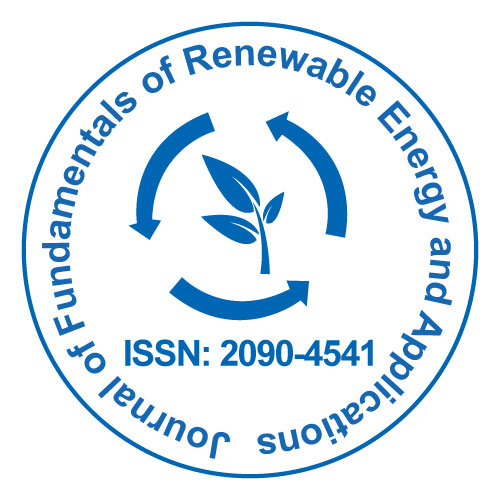
Journal of Fundamentals of Renewable Energy and Applications
Open Access
ISSN: 2090-4541
+44 1300 500008

ISSN: 2090-4541
+44 1300 500008
Commentary - (2023)Volume 13, Issue 3
Geothermal energy is a type of energy conversion in which heat energy from within earth's crust and mantle is captured and harnessed for cooking, bathing, space heating, electrical power generation, and other uses. The quantity of usable energy derived from geothermal sources varies depending on depth and extraction method.
Normally, heat extraction necessitates the use of a fluid (or steam) to transport the energy to the top. Finding and exploiting geothermal resources can be difficult. This is particularly true for the high temperature resources required for electricity generation. Such resources are usually restricted to areas of the world with recent volcanic activity, plate boundaries, or crustal hot spots. Even though earth is a constant source of heat, the extraction rate of heated fluids and steam can surpass the replenishment rate, necessitating sustainable resource management.
All direct use uses rely on low temperature geothermal resources with temperatures ranging between 50°C and 150°C (122°F and 302°F). Low temperature geothermal water and steam have been used to heat individual buildings as well as entire areas where multiple buildings are heated from a single supply source. Furthermore, geothermal energy has been used to heat many swimming pools, balneological (therapeutic) facilities at spas, greenhouses, and aquaculture grounds around the globe.
Cooking, commercial applications (such as drying fruit, vegetables, and timber), milk pasteurization, and large scale snow melting are all primary uses of geothermal energy. Hot water is frequently used directly in the heating system for many of these activities, or it may be used in combination with a heat exchanger.
Native Americans used geothermal energy for cooking as early as 10,000 years ago, according to evidence. Baths heated by hot springs were used by the Greeks and Romans in ancient times, and instances of geothermal space heating can be found as far back as the Roman city of Pompeii in the first century. Such geothermal energy applications were originally restricted to areas with access to hot water and steam.
Although the world's first district heating system was established in Chaudes-Aigues, France, in the 14th century, other towns and industries did not realize the economic potential of geothermal resources until the late 19th century. Geothermal heat was first supplied to a residence in the United States in 1892, to Warm Springs avenue in Boise, Idaho, and by 1970, the majority of the city was using geothermal heat. Reykjavik, Iceland, has the largest and most renowned geothermal district heating system, with 99 percent of the city receiving geothermal water for space heating since the 1930's. Among the first commercial direct-use uses was the extraction of borate compounds from geothermal fluids in Larderello, Italy, in the early nineteenth century.
Larderello was also the site of the first geothermal electric power production, with the construction of an experimental plant in 1904. Geothermal power stations were first installed in New Zealand in 1958, and in northern California at the Geysers in 1960. The plants in Italy and America were dry steam facilities, with low permeability reservoirs producing only vapour. High temperature and high pressure water, on the other hand, occurs naturally in New Zealand as a combination of 80% superheated water and 20% steam. The steam generated straight from the ground is immediately used to generate electricity.
By 2015, over 80 nations were using geothermal energy, either directly or in conjunction with GHPs, with China, Turkey, Iceland, Japan, Hungary, and the United States leading the way. In 2015, the total worldwide installed capacity for direct use was approximately 73,290 Megawatts Thermal (MWt), utilising approximately 163,273 gigawatt-hours per year (587,786 terajoules per year), resulting in an annual utilisation factor of 28 percent in the heating mode the annual energy produced by the plant (in megawatt hours) divided by the installed capacity of the plant (in megawatt hours) multiplied by 8,760 hours.
In the early twenty first century, geothermal energy was used to generate electricity in 24 nations, with the United States, the Philippines, Indonesia, Mexico, New Zealand, and Italy leading the way. Many geothermal fields have utilisation rates of around 95%, the highest of any renewable energy source. Before being injected back into the reservoir, "waste" fluid from the power plant is frequently used for lower temperature uses, such as the bottom cycle in a binary cycle plant. In the United States, Iceland, and Germany, such cascaded applications are common.
Citation: Rogris J (2023) Geothermal Energy as a Means to Decarbonize the Energy Mix of Megacities. J Fundam Renewable Energy App. 13:318.
Received: 06-Apr-2023, Manuscript No. JFRA-23-23329; Editor assigned: 10-Apr-2023, Pre QC No. JFRA-23-23329 (PQ); Reviewed: 24-Apr-2023, QC No. JFRA-23-23329; Revised: 13-Jun-2023, Manuscript No. JFRA-23-23329 (R); Published: 20-Jun-2023 , DOI: 10.35248/2090-4541.23.13.318
Copyright: © 2023 Rogris J. This is an open-access article distributed under the terms of the Creative Commons Attribution License, which permits unrestricted use, distribution, and reproduction in any medium, provided the original author and source are credited.